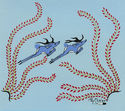
19th, 20th & 21st Century Fine Prints
707-546-7352 · fax 707-546-7924 · web: www.annexgalleries.com · email: artannex@aol.com
Marina Lujan Pop Chalee Biography
Marina Lujan Pop Chalee
American
1906–1993
Biography
Artist, muralist, and musician Pop Chalee was born Merina Lujan to Joseph Cruz Lujan, of the Taos Pueblo tribe of New Mexico, and Merea Luenberger, of Swiss descent, in Castle Gate, Utah, on March 20, 1906. After the death of Pop's brother Lawrence from scarlet fever in 1910, Joseph and the surviving siblings Pop, Mattie, and Eva moved to Taos Pueblo while Merea, who by then had converted to the strict Church of Jesus Christ of Latter Day Saints and had rejected her indigenous husband and children, stayed in Utah. In New Mexico, the sisters were able to attend the noted Santa Fe Indian School, and were encouraged in their pursuits by their aunt-in-law, Mabel Dodge Stern, a celebrated art patron and the wife of their uncle, Tony Lujan. It was in Taos Pueblo that Merina Lujan was given her Tiwa-language name, Pop Chalee, meaning "blue flower", which she would use throughout her professional career.
After returning to Utah in an attempt to reconnect with her mother as a teenager, Pop soon tired of her mother's fundamentalist life and left home at age 16 to marry Otis Hopkins, a craftsman and a Mormon. They had two children by the time Pop was twenty, and frequently moved between Taos and Salt Late City. It wasn't until she was nearly thirty that Pop began pursuing art as a career, inspired in part by the burgeoning appreciation of "Indian art" - not necessarily made by American Indians, but having to do with Native American culture - and in part due to her ongoing lectures on tribal culture and laws at LDS church meetings. At age 29, Pop enrolled once more in the Santa Fe Indian School to take classes in painting, muralism, and silkscreen printmaking from instructor Dorothy Dunn. While it took some time to get comfortable in her new pursuit - not only was she the oldest student in her class, but also the sole woman - it didn't take long for her to begin building a reputation as one of the American Southwest's most noted American Indian artists.
In addition to art, she took a job as an assistant to Kenneth Chapman, documenting the collection of American Indian pottery at the Laboratory of Anthropology Library, Santa Fe. This would prove to be a pivotal time for Pop, as she learned more about the traditional techniques, designs, and symbolism of Southwestern tribes. She became a vocal supporter of American Indian-made art and openly discussed the significance of indigenous imagery and its importance to the Western art world. During the Depression, Pop worked for the Indian Division of the WPA's Public Works of Art Project; this was the first time her artwork was seen throughout the U.S.
Her subject matter, which dealt with her tribe's lore and culture, proved to be popular with collectors. Throughout the 1940s and '50s her work was especially sought after by American West art collectors. She was commissioned to design murals and illustrate books, and continued to educate non-Natives about the importance of preserving and supporting American Indian arts and crafts, giving a lecture at Stanford University and writing for School Arts magazine.
Pop Chalee's work is included in the collections of the Gilcrease Museum, Tulsa, OK; the Heard Museum, Phoenix, AZ; and the Millicent Rogers Museum in Taos, NM. It has been exhibited at the National Gallery of Art in Washington, D.C., Stanford University, CA, and the Gallery of Living Artists, NY.
Pop Chalee died in Santa Fe, New Mexico, on December 11, 1993.

